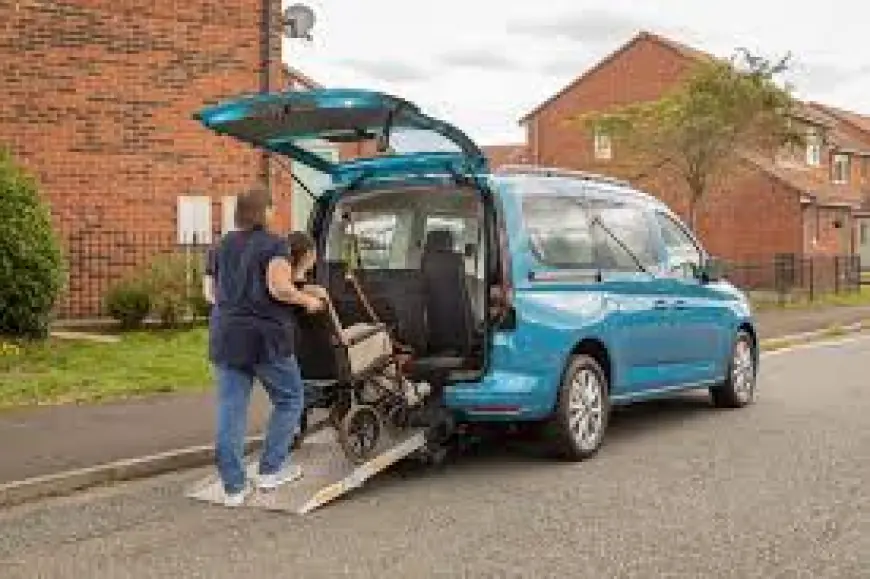Vehicles for Disabled Market 2030F Competitive Landscape Report
Key drivers of growth in the market are advancements in vehicle technology, which have improved the accessibility and comfort of vehicles for disabled users.

The Global Vehicles for Disabled Market is undergoing a transformation fueled by innovation, inclusivity, and a growing emphasis on accessibility. According to industry estimates, the market was valued at USD 5.39 billion in 2024 and is projected to reach USD 7.72 billion by 2030, expanding at a CAGR of 6.19% during the forecast period. This growth is supported by rising awareness about disability inclusion, advancements in assistive technologies, and government initiatives aimed at creating barrier-free mobility environments.
From the integration of wheelchair-accessible designs and automated ramps to the adoption of electric and hybrid mobility solutions, the sector is not just growing — it’s evolving toward a more connected, sustainable, and user-friendly future.
Emerging Trends in the Vehicles for Disabled Market
The vehicles for disabled segment is influenced by a range of emerging trends that are redefining product design, manufacturing, and service delivery. Key trends include:
1. Electrification of Accessible Vehicles
Electric and hybrid models are increasingly being adapted for disabled users. Automakers are introducing energy-efficient modifications that align with global sustainability goals while ensuring high accessibility standards. Lightweight battery systems, regenerative braking, and zero-emission technology are now finding their way into wheelchair-accessible vehicles.
2. Integration of Smart Technologies
Voice-activated controls, AI-assisted driving, and IoT-based monitoring systems are becoming mainstream. These advancements allow users to control navigation, climate, and entertainment without physical strain, improving the independence and comfort of passengers and drivers alike.
3. Customization & Modularity
Consumers are demanding vehicles tailored to specific mobility requirements. Manufacturers now offer modular designs, allowing users to add or remove accessibility features as needed, from swivel seats to adaptive hand controls.
Download Free Sample Report: https://www.techsciresearch.com/sample-report.aspx?cid=20829
4. Autonomous Driving Adaptations
The push toward self-driving vehicles is making its way into the accessible mobility sector. Semi-autonomous and fully autonomous systems are being designed to help those with severe mobility impairments travel independently.
5. Sustainability & Eco-Conscious Mobility
The market is increasingly aligned with green mobility goals, incorporating recyclable materials, low-emission powertrains, and efficient designs that minimize energy use while maximizing accessibility.
Market Drivers
Several factors are driving the sustained growth of the vehicles for disabled market:
1. Rising Demand for Inclusive Transportation
The global emphasis on social inclusion and disability rights is leading governments and manufacturers to develop products that meet the needs of all users.
2. Government Initiatives & Subsidies
Many countries are offering financial incentives, tax benefits, and subsidies for both manufacturers and consumers, making it easier to access high-quality accessible vehicles.
3. Technological Advancements
Innovations such as automated ramps, advanced wheelchair restraints, lightweight materials, and adaptive controls are improving vehicle usability and safety.
4. Aging Population
The growing proportion of elderly citizens worldwide is increasing demand for vehicles that cater to mobility-related health issues.
5. Improving Healthcare Infrastructure
Better healthcare outcomes are increasing the life expectancy of people with disabilities, leading to a larger consumer base requiring specialized mobility solutions.
Industry Segmentation Overview
Two-Wheelers
- Designed for shorter commutes and urban mobility.
- Equipped with larger footrests, custom seating, and enhanced stability.
- Offer affordability and independence for users with partial mobility.
Four-Wheelers
- Focused on comfort, safety, and advanced accessibility.
- Include features such as ramps, lifts, and hand controls.
- Ideal for severe mobility impairments requiring spacious interiors.
Both segments are shaped by regulations, technology adoption rates, and consumer preferences. While two-wheelers offer independence and affordability, four-wheelers provide comprehensive solutions for more complex mobility challenges.
Regional Insights
Asia-Pacific – Fastest Growing Market
- Large aging population and rapid urbanization.
- Strong government support for accessibility initiatives.
- Increasing adoption of electric and hybrid accessible vehicles.
- Rising middle-class income fueling demand for premium mobility solutions.
North America & Europe
- Early adopters of smart and autonomous driving technologies.
- Well-developed infrastructure for accessibility.
- Strong regulatory frameworks supporting inclusive mobility.
Industry Key Highlights
- Market size projected to grow from USD 5.39 billion (2024) to USD 7.72 billion (2030).
- Increasing integration of AI, IoT, and voice-control systems in accessible vehicles.
- Rising focus on green and sustainable vehicle modifications.
- Asia-Pacific identified as the fastest-growing market region.
- Significant investments in customization and modular vehicle design.
Competitive Analysis
The global vehicles for disabled market is highly competitive, with players focusing on product innovation, partnerships, and technology integration. Key companies include:
- Toyota Motor Sales, U.S.A., Inc.
- Creative Carriage Ltd.
- AMS Vans LLC
- Mobility Networks (Holdings)
- GM Coachwork Ltd.
- Vantage Mobility International
- Pride Mobility Products Corporation
- Electric Mobility Euro Ltd
- Brotherwood Automobility Limited
- Focaccia Group S.r.l.
Competitive Strategies in Focus:
- Expansion of product portfolios with electric and hybrid adaptations.
- Collaboration with advocacy groups for user-centered design.
- Investment in smart mobility features to enhance independence.
- Strategic mergers and acquisitions to expand geographic presence.
Future Outlook
The vehicles for disabled market is set for robust expansion in the coming decade. By 2030, we expect:
- Increased market penetration of electric and autonomous accessible vehicles.
- Greater cost reduction through scalable manufacturing and mass customization.
- Enhanced user experience through advanced AI-driven accessibility systems.
- Stronger public-private partnerships driving accessibility infrastructure.
- Broader adoption of subscription and mobility-as-a-service (MaaS) models for disabled users.
This forward-looking trajectory positions the market as a cornerstone of inclusive mobility solutions globally.
10 Benefits of the Research Report
- Comprehensive market size and forecast data through 2030.
- In-depth analysis of emerging trends and opportunities.
- Regional insights covering Asia-Pacific, North America, Europe, and others.
- Competitive landscape with detailed company profiles.
- Evaluation of key market drivers and restraints.
- Segmentation by vehicle type, driving option, and entry configuration.
- Insight into government initiatives and policy impacts.
- Technological analysis highlighting AI, electrification, and automation.
- Identification of growth opportunities in niche segments.
- Actionable intelligence to support investment decisions.
Conclusion
The Vehicles for Disabled Market is on the path to becoming a benchmark for inclusive, technology-driven mobility solutions. As governments, manufacturers, and advocacy groups continue to collaborate, the sector is likely to witness unprecedented growth in both innovation and accessibility. With sustainability and user independence at its core, the market is shaping the future of personal transportation for millions worldwide.
Contact Us-
Mr. Ken Mathews
708 Third Avenue,
Manhattan, NY,
New York – 10017
Tel: +1-646-360-1656
Email: [email protected]
Website: www.techsciresearch.com
What's Your Reaction?
 Like
0
Like
0
 Dislike
0
Dislike
0
 Love
0
Love
0
 Funny
0
Funny
0
 Angry
0
Angry
0
 Sad
0
Sad
0
 Wow
0
Wow
0



















































